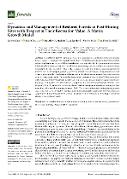Dynamics and Management of Restored Forests in Post-Mining Sites with Respect to Their Recreation Value: A Matrix Growth Model

Autor
Cienciala, Emil
Albert, Jan
Datum vydání
2022Publikováno v
Forests [online]Ročník / Číslo vydání
13 (9)ISBN / ISSN
ISSN: 1999-4907Metadata
Zobrazit celý záznamTato publikace má vydavatelskou verzi s DOI 10.3390/f13091519
Abstrakt
Afforestation has been a popular restoration procedure for spoil heaps in the sites affected by coal open-cast mining in the Czech Republic. Forest replantation is a frequent restoration variant when spoil heaps are recovered, but unreclaimed sites are often left to spontaneous succession. Studies on the dynamics of such restored forests are missing, and the evidence of restored forests with respect to their recreation value is also sporadic. To study the dynamics and management of restored forests-both replanted and recovered by spontaneous succession-on spoil heaps, we used a matrix growth model, which accounts for harvest, artificial and natural regeneration, and recreation value of these forest stands. The model calibration was performed on data from 250 inventory plots distributed across the Velka Podkrusnohorska spoil heap and the Matyas spoil heap in the Sokolov brown-coal mining area. The growth model was applied on six restored forest types to simulate-over 65 years with a 10-year cutting cycle-the effect of various management regimes of thinning on their recreation value and aboveground biomass (AGB). The results indicate that initial planting density and stand type have an effect on the dynamics of restored forest stands in the short-term horizon. Applying the thinning management resulted in an increase in recreation value for all types of restored stands, while AGB decreased.
Klíčová slova
forest reclamation, open-cast mining restoration, discrete growth model, spontaneous succession, thinning, attractiveness for recreation
Trvalý odkaz
https://hdl.handle.net/20.500.14178/1782Licence
Licence pro užití plného textu výsledku: Creative Commons Uveďte původ 4.0 International






